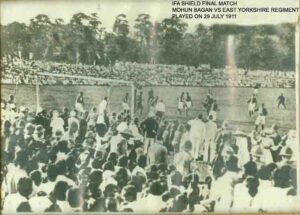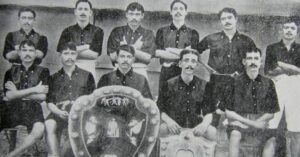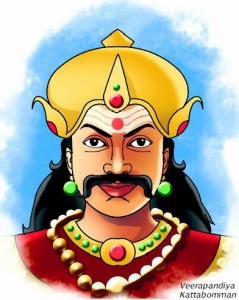Here is the untold story of the barefoot Bengalis who beat a British football team to become national icons way before the Non-Cooperation Movement!

 How many of us know of a football match in which an Indian team shattered the arrogance of the British Raj? In a story that is reminiscent of the landmark movie Lagaan, Mohun Bagan defeated East Yorkshire Regiment 2-1 in the IFA Shield final in 1911 — a time when the nationalistic movement was raging on in the country!
How many of us know of a football match in which an Indian team shattered the arrogance of the British Raj? In a story that is reminiscent of the landmark movie Lagaan, Mohun Bagan defeated East Yorkshire Regiment 2-1 in the IFA Shield final in 1911 — a time when the nationalistic movement was raging on in the country!
The year was 1910. In September, legendary Indian pehalwan Great Gama defeated Poland’s Stanislaus Zbyszko to be declared the world champion in freestyle wrestling. For the British, this victory was an occasion to celebrate as they considered it the triumph of a British subject over an uppity wrestler from Europe.
Little did they know that their own arrogance would soon be challenged in a sport they didn’t quite expect the “natives” to match them at Football.
In 1911, Mohun Bagan Athletic Club was invited to play in the prestigious Indian Football Association (IFA) Shield. Coached by the disciplinarian Sailen Basu, Kolkata’s oldest Indian football club had already gained a remarkable reputation and was considered the club that spoke for the country.
Mohun Bagan accepted the invitation and went on to have a great run in the tournament, ultimately reaching the final in top form. But to win the trophy they had pass their toughest test yet.
In the final, the eleven barefooted Indian players faced the far-better trained and booted East Yorkshire Regiment of the British Army. Back then, a pair of boots didn’t cost less than Rs 7 (an average schoolteacher’s monthly salary).
Unsurprisingly, the build-up to this game was unprecedented – scores of Indians travelled to Kolkata via train from outlying districts and neighbouring states. In fact, such was the demand that the East Indian Railway ran a special train and additional steamer services were used to ferry spectators to the ground.
On the day of the match, the Calcutta Football Ground was jam-packed with spectators who numbered between 80000 to 100000. People watched from treetops, telegraph posts and terraces of houses.
For those who didn’t have a good view, an ingenious method was devised to keep them informed of the scores— kites would be flown with the club’s colours and the score written on them.
The Indians knew that this was no ordinary football match, it was an opportunity to show up the British Raj at its own game.
Amidst this highly charged atmosphere, the match began on July 29, 1911. To the great disappointment of the Indians, it was Sergeant Jackson of East Yorkshire Regiment who scored first. With just 15 minutes left in the match, the Indian side of the stadium plunged into gloom.
The mood changed abruptly when Mohun Bagan skipper Shibdas Bhaduri equalised the scores immediately afterwards. And as the clock ticked towards the end of the match, centre-forward Abhilash Ghosh scored the winning goal to make it 2-1.
It took few minutes before the scene sunk in and reality dawned on the delirious crowd – Mohun Bagan had just defeated a British team to become the first Indian team to lift the coveted IFA Shield!
Chronicled in newspapers across both India and the world (including British newspapers such as the Times, Daily Mail and the Manchester Guardian), Mohun Bagan’s historic victory transformed them overnight into national icons.
“May God bless the Immortal Eleven of Mohan Bagan for raising their nation in the estimation of the Western people,” rhapsodized the Amrita Bazar Patrika (More than a century later, that team is still fondly remembered as “The Immortal Eleven”)
Reuters News Agency noted in its cablegram dated July 30, 1911 to England, “..the scene beggared description, the Bengalees tearing off their shirts and waving them..”.
“The members of the Muslim Sporting Club were almost mad and rolling on the ground with joyous excitement on the victory of their Hindu brethren”, wrote the Mussalman.
The Times of India reported: ‘On Thursday and Friday, every Bengalee carried his head high. And the one theme of conversation in the tramcars, in offices and in those places where the babus congregate most, was the rout of the King’s soldiers in boots and shoes by barefooted Bengalee lads.”
The Englishman’s summed up the win’s political importance in one line: “Mohun Bagan has succeeded in what the Congress and the swadeshiwallas have failed to do so far — to explode the myth that the Britishers are unbeatable in any sphere of life.”
In fact, such was the impression left by Mohun Bagan’s barefooted ball control that some Europeans were compelled to comment that “only in India does one get to see real football; everywhere else, bootball predominates”.
The triumph also established Kolkata as the nerve centre of football in India and laid the foundation for the city’s long-lasting love affair with football. In fact, in the years to come, iconic Indian footballer Chuni Goswami would turn down an offer to play for English side Tottenham Hotspur in favour of Mohun Bagan.
More importantly, the historic win shattered imperial arrogance at a time when Bengal was aflame with anger and agitation against the Raj’s decision to partition the province six years earlier. As noted sports historian Boria Majumdar wrote in 2013, “Mohun Bagan had become synonymous with the national battle cry for Vande Mataram.”
With the victory firing the imagination of the whole nation, the Swadeshi movement gained momentum. And finally, on December 11, 1911, the British Raj bowed to the movement and rescinded the partition of Bengal.
In fact, such was the public sentiment associated with Mohun Bagan’s victory that a local story went that the Union Jack fluttering over Fort William (the British headquarters in Calcutta) would come down only once Bagan won the Shield again. Intriguingly, it did prove true: the celebrated club won the IFA Shield next in 1947.
Interestingly, few Indians know that Mahatma Gandhi was a huge football aficionado and had even used the sport to spread his ideas. Sometime during his two-decade stay in South Africa (1893-1915), Gandhi started three football clubs (in Durban, Johannesburg and Pretoria) that were all named Passive Resisters Soccer Club!

